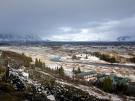|
|
 |

|
| Everything you wanted to ask about Iceland and you sort of knew anyway |
|
 |
|
Ultima Thule - The end of the world
330 BC An explorer named
Pytheas sailed north from Marseilles (in modern France) to discover how far the world would reach in that direction. He navigated
the British Isles and the northern seas and wrote about an island that he called Thule or Ultima Thule in his now lost work,
On the Ocean. This island was six days north of Britain and one day from "the end of the world". The island he found
is thought to have been Iceland. Ultima Thule - The end of the world
Come the Vikings
The settlement of Iceland by the Vikings started in 874 and was largely over by
930 AD. It was precipitated largely by internal struggles in Norway between the barbarian King Harald the Fairhaired
and former rulers. King Harald won a major victory late in the 8th century, after which he drove his enemies to the Scottish
Isles, which he then later conquered. Many of these people fled onwards to Iceland - which by then was well-known amongst
the Vikings - either directly from Norway or from the Scottish Isles, in order to evade Harald's rule.Come the Vikings
|
 |
|
Establishment of the Althingi
The Althing, Iceland's present-day parliament, is the world's
oldest existing national assembly. Founded at Thingvellir ('Parliament Plains') in 930 AD, the country's democratic system
of government was completely unique in its day. In the year 930, at the end of the settlement of Iceland, a constitutional
law code was written and the Althing parliament established. The judicial power of the Althing was distributed among
four regional courts, together with a supreme court which convened annually at the national assembly at Thingvellir.
Discovery
of
Greenland
Erik the Red (Eiríkur Rauđi) discovers Greenland in approximately
982 AD. He left Iceland with 25 ships loaded with prospective settlers, of which only 14 made it to Greenland. Around 984
AD they established the Eastern and Western settlements in deep fjords near the southwestern tip, where they thrived
for the next few centuries, and then disappeared completely after more than 450 years of habitation. When they were at their
most numerous, the farms in the Norse colonies reached 300 in number. These had some 5000 inhabitants who, among other
things, raised cattle, harvested the earth and hunted seals.
|
|
| Leif the Lucky discovers Vinland in North America |
Leif the Lucky discovers Vinland in North America
In 985 AD Erik the Red left Iceland and settled
in Greenland, founding there the first permanent colony. He returned to Iceland in 986 AD and gave accounts of a country
he called Grćnland ('Greenland'), hoping that the name would make it an attractive option for settlers. It was from this Greenlandic
colony that Erik's son Leifur Heppni ('Leif the Lucky') sailed in the year 1000 to discover North America, which he named
Vínland the Good. One of the more reliable Icelandic Sagas, however, suggests that Leif Eriksson heard of Vínland from
another Icelander, Bjarni Herjólfsson, who had sighted it some 14 years prior. Whatever the truth is, these voyages of exploration
became the source material for one of Europe's greatest periods of literature. In 1960 archaeological evidence of Norse
settlement in North America was found at L'Anse aux Meadows on the island of Newfoundland, though it is not known for how
long the settlement survived.
|
|
 |
|
|
|
| The Land of Ice and fire. |
The land of ice and
fire
Laki in Iceland
in 1783 caused the death of all the animals and 5% of the population on the island, and may have caused the crop failures
in Europe that provoked the French Revolution. Dust clouds from volcanoes cause cold weather which shows
up as frost damage in tree rings.Land of Ice and fire
The Glaciers
Vatnajökull is the biggest glacier in Europe. It covers about
8% of the country and the average thikness is 400m. Under the ice-cap are still active vulcanos and in Grimsvotn vulcano,
Iceland's most active since the Middle Ages erupted in 1996, 1998 and 2004. Seven central volcanoes are situated underneth
the Vatnajokull ice-cap.
The Kverkfjöll is a large glaciated central vulcano on the northern edge of Vatnajokull, with
a powerful highteo-nature ared where there are mudholes. Steam bowholes and a luke-warm lake. Undereneath the glacier is an
ice cavern system several km long.The Glaciers
|
 |
|
|
|
|
|
Feedback, submissions, ideas? Email svanurg@gmail.com
|
|
|
 |

